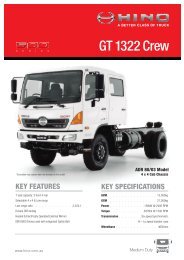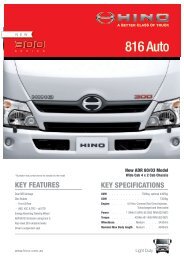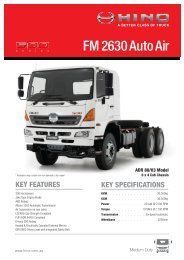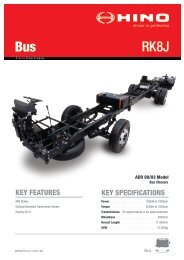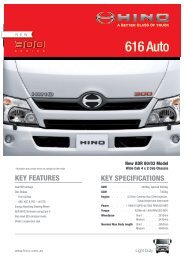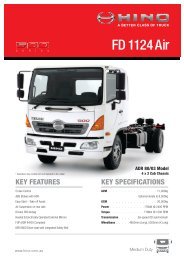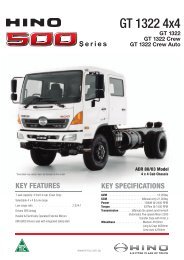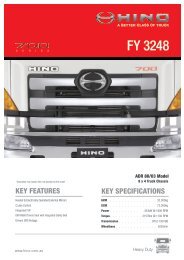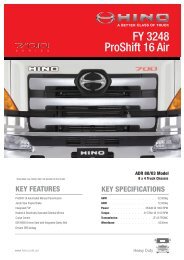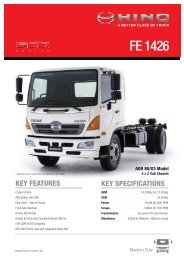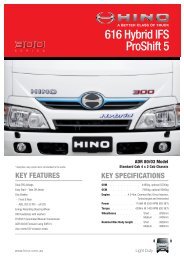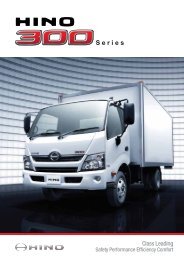Slicker - Hino
Slicker - Hino
Slicker - Hino
You also want an ePaper? Increase the reach of your titles
YUMPU automatically turns print PDFs into web optimized ePapers that Google loves.
DRIVEN<br />
City<br />
<strong>Slicker</strong><br />
<strong>Hino</strong>’s 700<br />
Series is<br />
ideal for<br />
local delivery<br />
work where<br />
minimising<br />
fatigue ranks<br />
high on the<br />
agenda<br />
The<br />
competition is certainly<br />
hotting up with the<br />
start of 2011, and the Japanese importers are all wondering<br />
about the impact on their market share of the soon-to-bereleased<br />
Chinese truck alternatives. Admittedly, the Chinese<br />
manufacturers, like the Koreans, are starting at the light<br />
truck end of the market, but that’s only the tip of the iceberg.<br />
There’s plenty of heavier weight product just waiting in<br />
the wings, with the respective importers of Chinese trucks<br />
watching how their first toe-in-the-water exercise takes off.<br />
<strong>Hino</strong> has been working hard at improving its brand<br />
specification and reputation, and at the top of the range the<br />
<strong>Hino</strong> 700 Series becomes worthy of close inspection because<br />
of its ability to blend Japanese functionality with European<br />
technology. In the case of the 700 Series, it’s a matching of<br />
Japanese engine to European transmission in the form of<br />
the ZF AS-tronic 16-speed automated manual gearbox. Is it<br />
worth the effort? You bet!<br />
Regular readers<br />
of PowerTorque will know<br />
we’ve evaluated the 700 Series as<br />
a prime mover and single trailer around the<br />
busiest parts of Sydney in peak hour as we hauled a full 42<br />
tonnes GVM in and out of tight city streets. This time we took<br />
our drive further down the road, with an interstate run from<br />
Melbourne, northwards up the Hume Highway, to Sydney.<br />
The main reasoning for the longer run came down to giving<br />
us the chance of running proper fuel economy evaluations,<br />
as running in an urban environment is prone to so many<br />
influences, making a true fuel consumption figure harder to<br />
establish. And the other information the run provided was<br />
whether Japanese horsepower is really based on smaller<br />
horses than their European counterparts.<br />
48 PowerTorque ISSUE 39
CITY SLICKER<br />
As a local haulier running intrastate the <strong>Hino</strong> 700<br />
has much to offer in value and ease of driving.<br />
We’ll start with the<br />
cab interior, which<br />
has had some additions<br />
and upgrades since first being<br />
introduced.<br />
Access and egress is easy, thanks to well placed<br />
grab handles, easy to find, well spaced steps and<br />
a relatively flat floor. It’s not a straight step-across type of<br />
flat floor, as the centre console does restrict clear crossover<br />
access, but it’s not that difficult, either, to get from one<br />
side of the cab to the other. The high roof is similar to the<br />
European competition, but storage is reduced compared to<br />
something like a Volvo or Scania alternative. There are two<br />
small over windscreen lockers, a full-width over windscreen<br />
shelf with mesh net front and there are two indentations<br />
with corresponding coat hooks in each rear side panel, to<br />
accommodate coats of jackets on a hanger.<br />
The front passenger gets a fixed base seat, but the driver<br />
gets the always-impressive Isri air-suspended 6860 seat<br />
with integral seat belt. It’s weight and height adjustable,<br />
and provides a good range of variation to find the ideal<br />
combination. Assisting the driver in finding the right position is<br />
the tilt, rake and height adjustable steering column, which has<br />
a huge range of permutations to suit any driver size.<br />
As with all Japanese cabs, the bunk area is not built for<br />
entertaining. The bottom bunk can be configured with a<br />
mattress extension to give a width of 800 mm, or there’s the<br />
added alternative of folding down the upper bunk. For those<br />
intent on a good sleep, there’s curtain railing already installed,<br />
running around the outer edge of the cabin and across the<br />
windscreen area to shield off the total cabin interior. The centre<br />
console also has plenty of indented trays, plus a small locker<br />
for keeping glasses, wallets and coins from dropping onto the<br />
floor.<br />
Visibility is excellent thanks to large, power-adjusted door<br />
mirrors and separate convex spotter mirrors mounted below.<br />
They’re vibration free and are heated to keep vision clear. What<br />
we did find though, when we hit the heavy inner city traffic in<br />
Sydney around the airport at the end of the drive, was that<br />
vision would benefit from a kerbside mirror on the left-hand<br />
door, above the passenger window. There’s a considerable<br />
blind spot between the front A-pillar and the B-pillar that could<br />
be cleared up with a convex kerb mirror for added safety.<br />
PowerTorque ISSUE 39 49
DRIVEN<br />
The ease of driving could attract a whole new group of drivers<br />
as Maree found when she took the wheel.<br />
holding vehicle speed as well as reducing it, even on long and<br />
relatively steep declines. It’s such a valuable addition, that any<br />
extra cost associated with its inclusion will be easily recouped<br />
through a reduction in service brake application and wear. It<br />
also enables hill descent speed to be more closely controlled<br />
to keep within posted upper speed limits.<br />
The ride comfort is not quite on equal terms with European<br />
makes, but, with semi-elliptical tapered leaf springs at the front<br />
and Hendrickson HAS airbags on the rear, neither is it harsh.<br />
Those looking for tipper work, or different applications, can opt<br />
for a six-rod rear end.<br />
Throughout the drive north from Melbourne, and running at<br />
full gross weight, we certainly averaged acceptable journey<br />
times and average speeds, but that also calls into play<br />
whether you’d want to buy such a prime mover for long haul<br />
work, even if hauling high volume loads rather than running at<br />
maximum weight.<br />
Under the cab is a <strong>Hino</strong> 12.9-litre, common rail injected,<br />
turbocharged and intercooled overhead camshaft diesel that<br />
produces 353 kW (480 hp) at 1800 rpm, and peak torque of<br />
2157 Nm rated at 1100 rpm.<br />
When running in 16th gear at 100 km/h, the engine spins<br />
happily at the 1600 rpm area, and holds the gear strongly<br />
down to the top half of the green band. Once it drops under<br />
1300 rpm the torque does drop off, and it’s here that you’ll<br />
find the AS-tronic is quick off the mark to change for a lower<br />
ratio. If you want to over-ride the automated change and drive<br />
it manually, especially on the approach to the crest of a hill,<br />
a light push forwards on the selector will take the AMT up<br />
one gear, push further forwards and it will take a double gear<br />
upgrade.<br />
With an overall fuel consumption of 2.11 km/litre, the <strong>Hino</strong><br />
acquitted itself well, but also illustrated that its forte will be for<br />
city work rather than the great open highway. It would be ideal<br />
as a day truck running trailers for changeover, but, even with<br />
its twin bunk and high roofed interior, it was never going to<br />
be a popular alternative to longer haul, overnight or interstate<br />
work.<br />
As a reliable and honest workhorse, the <strong>Hino</strong> 700 Series<br />
offers a great engine/transmission mix, and, with the ZF<br />
intarder, it’s well worth a close look if you’re in that segment<br />
of the market.<br />
The ability of the software to pick the most appropriate<br />
gearing is impressive, but you can improve on its<br />
performance, particularly when accelerating on relatively<br />
flat roads from rest, by manually selecting each change,<br />
skipping up two ratios at a time in the box and giving better<br />
acceleration.<br />
The big advantage of the ZF automated manual is really<br />
felt whenever you hit the city. All you have to do, as a driver,<br />
is avoid everything happening around you, as the Electronic<br />
Control Module is well up to the task of finding an appropriate<br />
gear ratio for whatever life throws at you.<br />
If you have to manoeuvre at very low speeds, the driver hits<br />
a “slow” button alongside the gear shift, with 1st or reverse<br />
engaged, and this reduces speed for situations such as<br />
parking or reversing onto a loading dock.<br />
As part of the ZF AS-tronic transmission you get the option<br />
of the ZF intarder, and this is such a good addition you’d be<br />
mad not to include it on the specification. With its five-position<br />
control wand on the steering column, you can bring on as<br />
much retardation as you want, and it’s well capable of<br />
50 PowerTorque ISSUE 39



